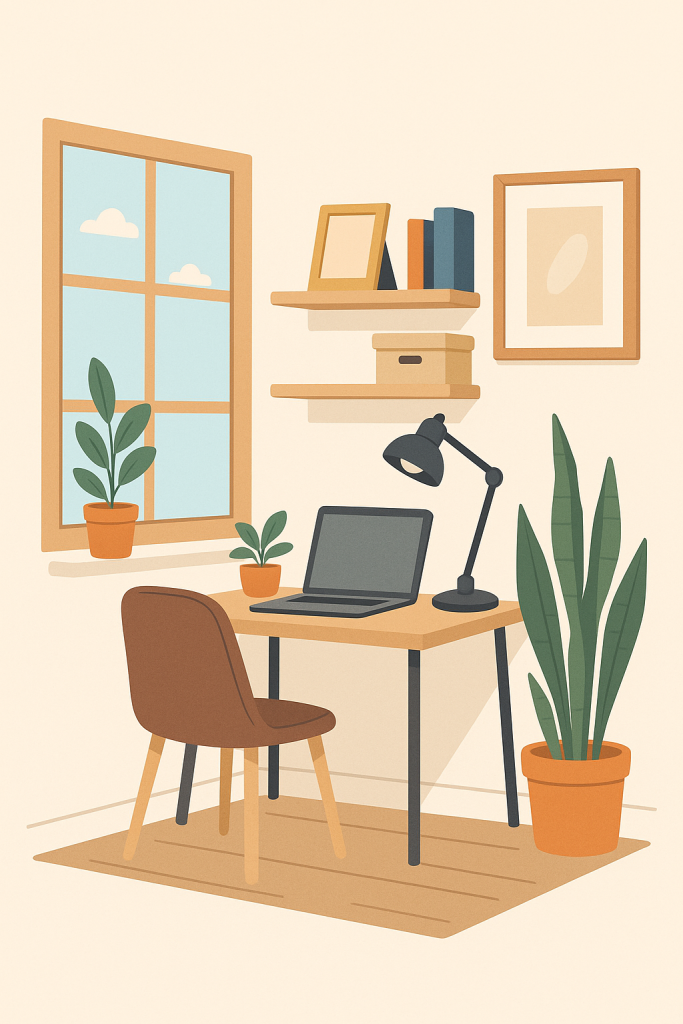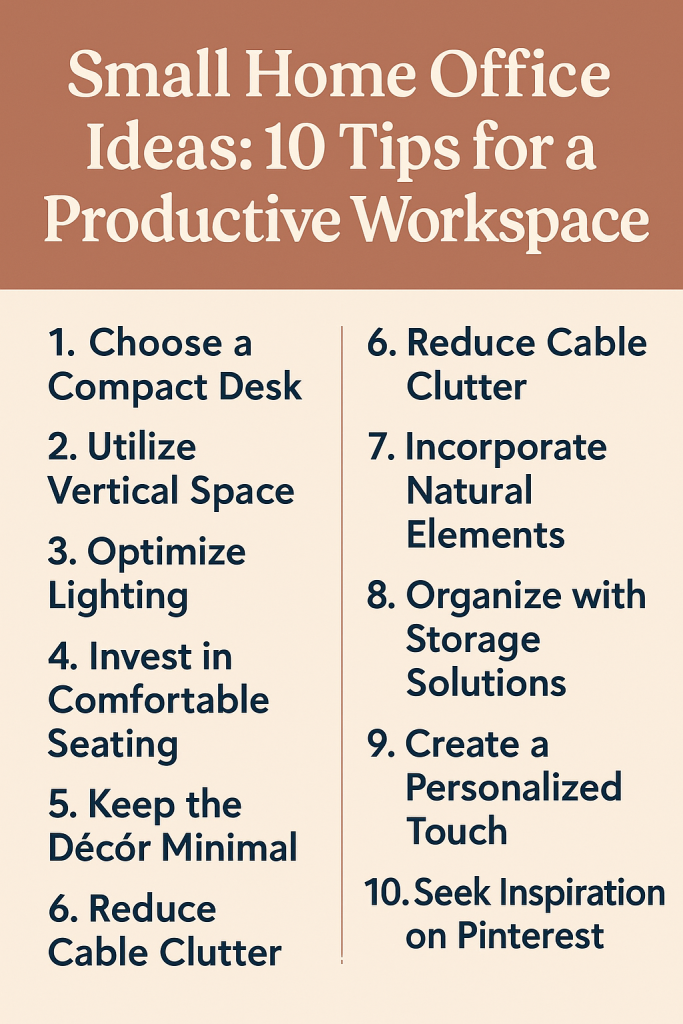Small Home Office Ideas: 10 Ways to Create a Productive Workspace

Introduction
Not everyone has a spare room for work, but that doesn’t mean you can’t build a focused, comfortable setup. With a few smart choices, even a 1–2 m² corner can feel intentional and productive. The key is to prioritize function, reduce clutter, and use design to visually open up the space. Below are ten small home office ideas that help you work better without needing a big renovation or big budget.
1) Use Vertical Space
When floor space is limited, your walls become prime real estate. Install floating shelves above or beside your desk to hold books, storage boxes, and peripherals you don’t use every hour. A pegboard or rail system lets you hang headphones, scissors, cables, or small bins so essentials are visible but off the surface. Consider a wall-mounted monitor arm to free desk space and keep screens at eye level.
Pro tip: leave ~20% “air” on each shelf for visual breathing room; use uniform bins + clear labels so you can grab what you need in seconds.
2) Choose Compact Furniture

Small spaces reward furniture that does more with less. A ladder desk, narrow (120–140 cm) writing desk, or corner desk maximizes utility without crowding. If you need true flexibility, a fold-down/wall-mounted desk disappears after hours.
For inspiration on space-saving furniture, explore IKEA’s small home office solutions.
Pick a slim, supportive chair—arms can bump walls in tight corners, so try armless if you’re very close to a side wall. Add a rolling pedestal for files that parks under the desk.
3) Optimize Natural Light
Light shapes mood and focus—and it makes rooms feel bigger. If possible, place the desk perpendicular to a window to gain daylight without harsh glare. Diffuse strong sun with sheer curtains; add a mirror opposite the window to bounce light deeper into the room. Complement daylight with a task lamp (4000–5000K, CRI ≥90) for accurate color and crisp text.
💡 For more ideas on maximizing small spaces, check HGTV’s design tips.
4) Keep It Minimal
Minimalism isn’t about bare; it’s about only what helps you work. Define a simple desk loadout: laptop/monitor, keyboard, mouse, lamp, water. Everything else gets a dedicated home. Use cable clips, an under-desk tray, and velcro ties to tame tangles. Set a weekly 10-minute reset to put items back and wipe surfaces.
Design tip: pick 1 neutral + 1 accent color for accessories so the small space feels cohesive, not busy.
5) Add Plants for Freshness
Greenery brings life to tight rooms and softens tech-heavy setups. Choose low-maintenance, small-footprint plants like pothos, ZZ plant, snake plant, or a mini succulent; they tolerate varied light and need minimal watering.
6) Create a Dual-Purpose Area
No separate room? Build a “cloffice” (closet office) with a shallow desk and a light; close the doors to end the workday. In living rooms or bedrooms, use a screen, curtain, or rug to define the work zone visually.
7) Use Light Colors
Light, low-contrast palettes reflect more light and visually expand the room. Whites with a warm undertone, light greige, or soft pastels keep things bright without feeling sterile.
8) Organize with Smart Storage
Small offices thrive on hidden order. Use a rolling cart for printers or paper; slide it under the desk or into a closet. Try vertical file organizers for active projects and under-shelf baskets to double cabinet capacity.
9) Personalize Your Small Office
A few curated touches go a long way. Pick one framed print, a small pinboard or grid, and a desk mat to add color and define the work zone.
💡 According to Harvard Business Review, personalizing your workspace can boost motivation and engagement.
10) Find Inspiration on Pinterest
When space is tight, smart ideas are everything. Browse clever layouts, slim desks, and “cloffice” builds on Pinterest to shortcut your planning.
👉 Explore Pinterest for inspiration and use SavePinMedia.com to download your favorite visuals for offline access—handy when you’re shopping or sketching a layout away from Wi-Fi.

Conclusion
A great small office is intentional, organized, and light. Use walls, choose compact ergonomic pieces, keep surfaces minimal, and add a few personal cues that make you want to sit down and start. With smart storage and steady habits, even the tiniest corner becomes a focused, productive workspace—and with a Pinterest mood board saved offline, you’ll never run out of ideas.